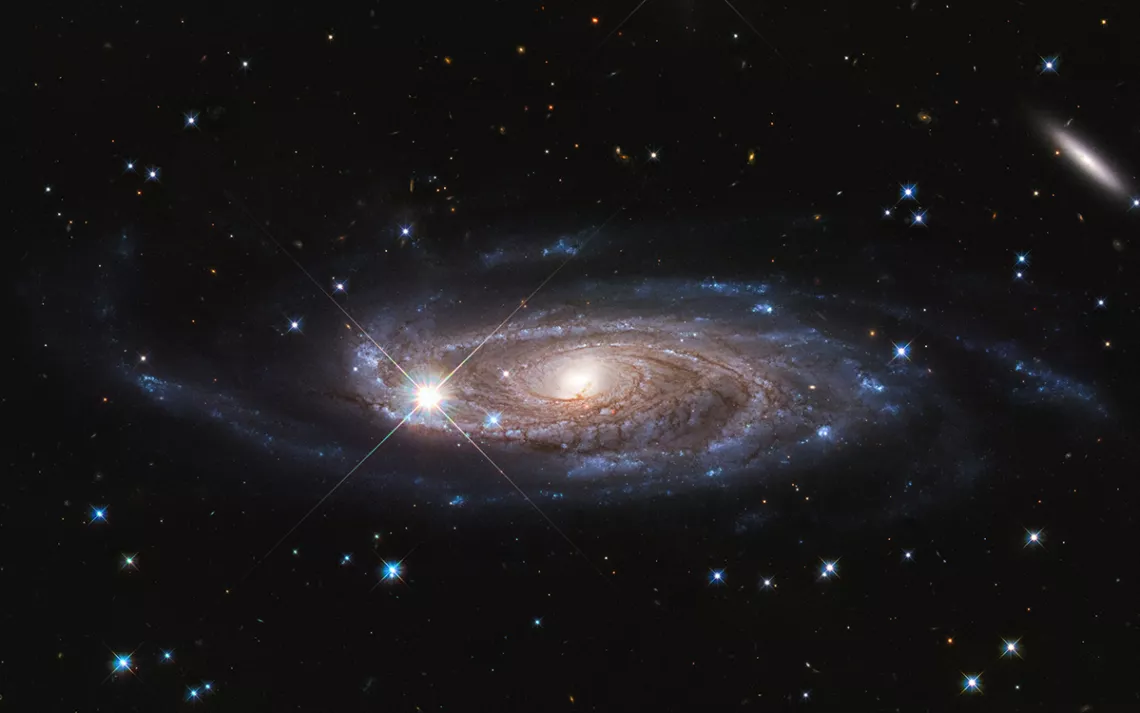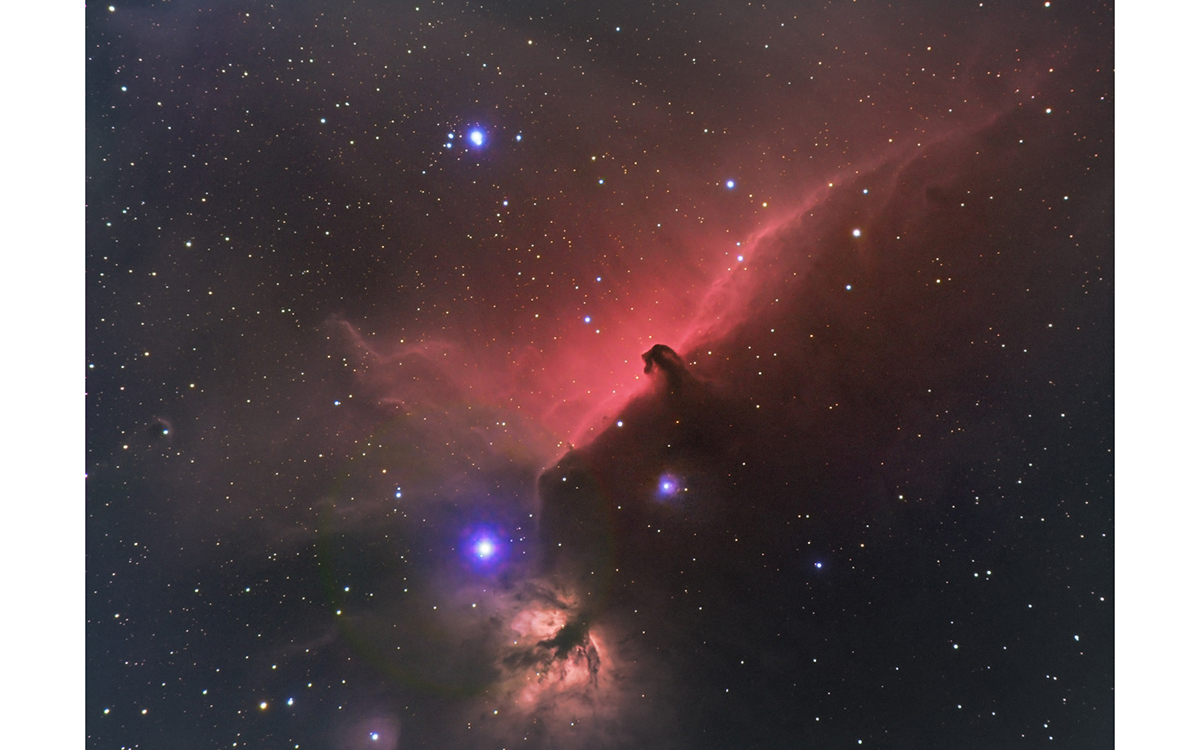January Stargazing: Mapping the Universe
Knowing where we are is a form of empowerment

This Hubble Space Telescope photograph showcases the majestic spiral galaxy UGC 2885, located 232 million light-years away in the northern constellation Perseus. The galaxy is 2.5 times wider than our Milky Way and contains 10 times as many stars. Photo by NASA, ESA, and B. Holwerda (University of Louisville).
I remember a T-shirt that belonged to an elementary school friend back in the 1980s. He wore it so often that it began to thin noticeably. Eventually holes formed in the dark-blue fabric. The shirt showed a swirling Milky Way galaxy along with an arrow pointing to one of its outer spiral arms. Above the arrow, a caption declared in simple type, YOU ARE HERE.
It’s an age-old question—Where are we in the universe?—one that has consumed philosophers and professional astronomers alike.
My friend’s tattered T-shirt, I think, provided a clever answer. With tongue-in-cheek precision, it pinpointed our location in the confines of the Milky Way, our cosmic abode that we have never actually glimpsed from the outside. The deeper meaning of the shirt, of course, was ironic, perhaps even existential—serving as a reminder of our smallness against the blue-black backdrop of space. Like the pollen-grain world in Dr. Seuss’s Horton Hears a Who!, we drift through the cosmos among objects we can barely perceive, subject to forces we have no control over.
Such notions can easily lead to despair, or worse, apathy. In an inconceivably vast universe, does it really matter where we’re located? Isn’t one place, fundamentally, the same as another?
But knowing where we are with more specificity seems to me like a form of empowerment. If we could understand our place in the cosmos, our cosmic address as it were, might we change our behavior? Would it alter the way, for example, that we take care of our home planet and one another? And could such knowledge give us a better sense of where we’re headed? I’m thinking here not merely of our travels through the cosmos aboard spaceship Earth but also of our aspirations as self-propelled voyagers among the stars. We can only begin to ponder such questions once we have figured out our actual location with a degree of accuracy that goes well beyond an arrow on a T-shirt.
Which is to say, we need better maps.
That is exactly what a consortium of astronomers known as the Sloan Digital Sky Survey is trying to do. For more than 20 years, this international team of researchers from dozens of institutions has been building the most detailed 3D map of the universe in existence. The survey’s main tool is a massive, custom-designed telescope of a variety known as a Ritchey-Chrétien, which, to my eye, looks like a squid breaking out of a shipping container. Located at Apache Point Observatory in southeastern New Mexico, the scope—along with its southern hemisphere counterpart in northern Chile—has been making systematic sweeps of the sky.
The SDSS survey has collected data on millions of deep space objects—stars, nebulae, and galaxies along with more exotic objects such as black holes, pulsars, and quasars. With all this data in hand, astronomical mapmakers stitched the individual frames together to produce highly detailed, three-dimensional color maps. Using specialized software, a viewer can “fly” across hundreds of billions of miles and tens of millions of years of cosmic history, as if on board a spacecraft traveling faster than the speed of light.
The deeper we delve, the stranger things get. Among the profundities of peering far into space is finding that our place in the cosmos is as much about knowing “when” we are as it is “where”—thus, trying to visualize the universe in its totality becomes an exercise in time travel. Using the SDSS’s maps, we can look back billions of years and get a glimpse of the universe in its infancy, during its first 300,000 years (if the universe’s 13.7 billion years were compressed into a single day, that timespan would be equivalent to the first few seconds after midnight). In this embryonic universe, matter as we know it existed in a primordial and incomplete state. Things were hot and jumbled. Electrons roamed free. It would be tens of thousands more years before electrons would get caught up in orbits around positively charged nuclei to form the first atoms, namely hydrogen and helium. Some 150 to 200 million years later, those elements would congeal, forming the first stars.
To the space researcher, the potential uses of SDSS data are many. With it, scholars can visualize the conditions of the early universe as well as get a better sense of how it’s evolving. Among the key findings of SDSS is that the expansion of the universe, which began roughly 6 billion years ago—driven by what physicists believe is a strange and elusive component of the universe known as “dark energy”—is occurring about 10 percent more slowly than predicted by Einstein’s theory of relativity. The SDSS researchers don’t know the reason for the discrepancy but suspect that a “previously unknown form of matter or energy” in the early universe could be the culprit.
We non-specialists will most likely experience the Sloan Survey’s findings at the local planetarium. Using these maps, planetarium astronomers will soon be able to take visitors on an immersive journey through the cosmos, whizzing through our solar system, past distant nebulae, far beyond the fringes of the Milky Way and into the starless wastes of intergalactic space. Fasten your seatbelts.
As a lover and collector of maps, I can’t help but envision the SDSS as a road atlas for future interstellar travelers, the equivalent of the tattered map beneath the seat of a tricked-out van. On their journey away from Earth, these pioneers may stumble upon some secrets of the universe—perhaps in their voyages they will be the first to learn if we are alone in our cosmic cul-de-sac. “Only those who will risk going too far,” wrote T.S. Eliot, “can possibly find out how far one can go.”
Here on planet Earth, in the first days of the 21st year of the third millennium, with our movements restricted by COVID, the Sloan Survey allows us to imagine travel on the grandest of scales. Right turn at Neptune, proceed on the route for 642 light-years to Betelgeuse. At home with my scope, looking out from Earth’s thin crust, I envision an updated version of the T-shirt worn by my friend all those years ago. The galaxy is the same, but the arrow, rather than pointing to one of the Milky Way’s spiral arms, is aimed away from the edge of the solar system, into space. The caption reads, THE JOURNEY BEGINS HERE.
WHAT TO LOOK FOR IN JANUARY
This month the winter constellations assume center stage. Orion, the gem of the Northern Hemisphere, rises high into the sky. Within its boundaries lie some of the brightest stars and the most striking deep-space objects in our corner of the Milky Way. Find the left star in the three-star assemblage of Orion’s belt. That point of light, a second-magnitude star known as Alnitak, marks one of the most beautiful nebulae visible from Earth: the Horsehead Nebula. At 1,500 light-years away, this particular interstellar cloud is unmistakable and iconic, with its perfect horse-shaped patch set against red, undulating plumes of ionized gas. The Horsehead is difficult to see from urban locations, but stargazers in dark-sky sites with small telescopes or binoculars should be able to make out a faint wisp surrounding Alnitak.

Moon watchers will not want to miss the Wolf Moon, which appears on January 28. The midwinter moon is the cold-weather counterpart of the summer sun. In January, it rises high into the night sky, to an altitude that closely matches that of the summer sun.
For meteor shower aficionados, look out for the Quadrantid meteor shower late on January 3. To find them look below the handle of the Big Dipper. As far as showers go, the Quadrantids are notoriously short but can be sweet. In the best years, according to NASA, viewers can see as many as 200 meteors per hour. This year, however, a bright waning gibbous moon will obscure many of the fainter streaks. But viewers willing to brave the cold should still be able to see as many as 25 to 30 meteors per hour.
 The Magazine of The Sierra Club
The Magazine of The Sierra Club



